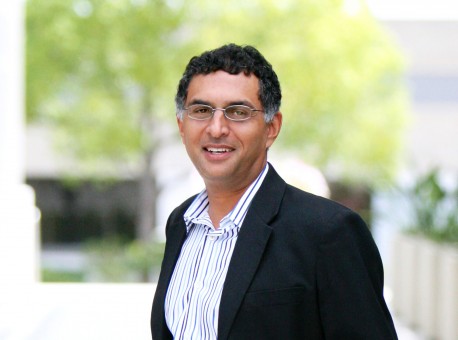Rohit Anand – Fairfax County Considers Turning the Silver Line into a Massive Public Art Project
The Washington Post
April 9, 2014
The time to debate whether the Silver Line should run above ground or below it has long since passed.
But now that the tracks have been erected, in some places 40 feet above the ground, the discussion has begun about how to make the staggering concrete trestles less, well, unsightly.
“We have a lot of bare concrete,” said Sharon Bulova, chair of the Fairfax County Board of Supervisors. “We have attractive stations, but a lot of pretty stark, bare concrete.”
It may have been difficult to picture the structure when they existed only in planning documents, engineering drawings and architectural renderings, but now that the the tracks are up in Tysons the more than 100 supports can seem impossibly large and bulky, said Michael Caplin, executive director of the Tysons Partnership.
“It’s hard to picture something 40 feet into the air,” Caplin said. “And to envision 100 in a row? They look very different than they do in an artists’ rendering than when you are standing underneath them.”
Bulova said she wanted to see if there was some way to beautify or at least cover some of the unsightly concrete.
“We’re exploring if there are things that we can do at this time or in the near future to make the appearance more pleasing and also to ensure the vitality and the energy and the attractiveness that we would like to have in Tysons,” she said.
Bulova did some brainstorming with Rohit Anand, a principal at the architecture and planning firm KTGY. Then Caplin commissioned some designs from New York consultant Sophie Ann Terrisse, of STC Associates (who also helped design the partnership’s Tysons logo).
Terrisse said she viewed the size and visibility of the structures a chance to do something grand. She produced some quick examples of how the trestles might be able to be painted or wrapped. “This is one of those projects where Michael said, ‘Could we do something interesting?’ And I said, ‘No we could do something extraordinary,’ ” she said.
The example concepts are awfully bright, but Terrisse said she wanted to generate some ideas for how big Fairfax County officials and property owners should be thinking.
“When you look at the structures, we wanted to give the entire group ideas about what has been done in other cities around the world but especially in Europe. What’s daunting about the structure is as you drive through it you have different heights and widths of structures and very different landscape as you go,” she said.
“It’s really about how you open the mind to make the new downtown, make it a really exciting and kind of organic part of Tysons altogether,” she added.
Not everyone is sure painting or wrapping the trestles is a good idea. Barbara Byron, director of the county’s Office of Community Revitalization, said she would prefer to see some lighting added to the structures the way some cities do with bridges or landmark buildings.
“The kind of place that we’re hoping Tysons will be is this forward-looking, energetic environment and ideally this could play a role in that,” she said.
Lighting the trestles could be problematic because Metro would then likely be responsible for maintaining the lightning and, for instance, replacing light bulbs that are 40 feet in the air above busy roadways.
There also isn’t any money for the project yet. Few Fairfax County residents appear pleased at the proposed spending levels for schools, police and other core services next year, much less paint or vinyl coating for the Metro columns.
Caplin said a rough estimate for what it would take to paint a 30-foot trestle, depending on many factors, might be $10,000, which would include one coat of primer and two coats of paint. He and Byron were optimistic that one of the larger Tysons landowners would “adopt” a tressle or two near its property by footing the bill for a design.
“We could take one column and make it beautiful and then study what to do next,” Caplin said.
More ideas are on the way. County officials are planning a charrette for May or June. Of course, if Fairfax decides not do anything, someone else could.
“I guess the biggest concern is graffiti,” Bulova said. “I mean, let’s face it, it’s a big target.”

